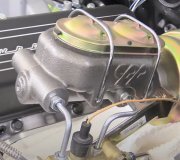First thing to check is if the right front brake is working. I don't know if this applies to cars with anti-lock brakes, but if the left rear and the right front both do not work, this is a very common problem on GM front-wheel-drive cars. It can be caused by being surprised by a sudden leak, and by improper bleeding procedures. There is a valve in the master cylinder that blocks one port when the two hydraulic systems build unequal pressures. Opening a bleeder screw will prevent that circuit from building any pressure, but the valve won't trip if you don't push the brake pedal over half way to the floor. Once tripped, you won't get any brake fluid to those two wheels no matter how hard you push on the brake pedal. That prevents losing brake fluid to an external leak such as a ruptured rubber flex hose.
(Professionals never push a brake pedal over half way down because doing so runs the rubber lip seals over crud and corrosion that form in the lower halves of the two bores where they don't normally travel. That can rip the seals resulting in a slowly-sinking brake pedal, and that often doesn't show up until two or three days later).
Almost all front-wheel-drive cars use a "split-diagonal" hydraulic system because there's such a high percentage of weight in the front. With a failure in one circuit, you'll still have one working front brake. To prevent a horrendous brake pull to one side, the suspension geometry has been redesigned. The alignment angle is called "scrub radius". On Chrysler products you won't even know there's a failure of half of the system except for the red "Brake" warning light. On most other cars most people also won't notice a problem, but if you're very observant, you'll see a very tiny wiggle in the steering wheel when you apply the brakes.
If it appears the valve in the master cylinder is tripped, the only way I have ever found to reset it is to go to one of the non-working wheels, (I prefer the front wheel), loosen the cap on the reservoir, open the bleeder screw, and give it a quick, short burst of compressed air. You don't want to stuff so much air in there that it makes it all the way up to the master cylinder. You'll just have to bleed it out again. I give one short wrap on the air nozzle's handle, then let that line gravity-bleed for a few seconds.
Some people will tell you to bleed the right rear first, thinking that will get the air out of the longest line first and make bleeding the others easier. Fooey! Some will tell you to bleed the left front first because it is the shortest and will take the least amount of effort to get all the air out of one line. Phutt! Sometimes the service manual will specify the order for bleeding to avoid tripping the valve. If that were true, that valve would never trip if a certain wheel had the leak, and we know that isn't the case. The wheel I always bleed first is the one I'm standing closest to. And I never bleed with a helper. Gravity-bleeding is the only method I use.
Also remember that when you install new front disc brake pads, you have to pump the pistons back out of the calipers so the pads will contact the rotors. One piston is always going to lag behind the other one at first, then one side will build pressure before the other side does. THAT can also trip the valve.
Often do-it-yourselfers who don't notice the non-working brake like you did don't even know there is a problem until the new pads wear out on one front wheel two or three times while those on the other side still look like new. That is a sure sign the valve in the master cylinder is tripped.
Thursday, August 4th, 2016 AT 1:30 AM


